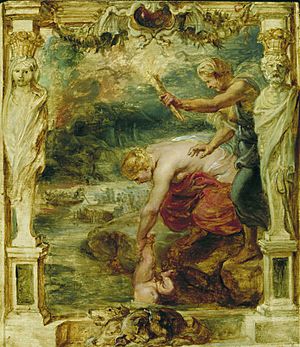Achilles' heel facts for kids
An Achilles' heel is a weakness that can cause someone or something strong to fail. Even though the original story is about a physical weakness, people often use the phrase to talk about any hidden flaw or weak point.
The Story of Achilles
In ancient Greek mythology, there was a hero named Achilles. When he was a baby, it was predicted that he would die young. To try and prevent this, his mother, Thetis, took him to the River Styx. This river was believed to make anyone who touched its waters invulnerable, meaning they couldn't be harmed.
Thetis dipped baby Achilles into the river. However, she held him by his heel, so that part of his body never touched the magical water. Because of this, his heel remained the only vulnerable spot on his otherwise invincible body.

Achilles grew up to be a mighty warrior. He fought in many big battles, including the famous Trojan War. Although the poet Homer mentioned Achilles's death in his epic poem Iliad, the actual event isn't described there. Instead, other ancient Greek and Roman stories tell us what happened.
During the Trojan War, Achilles was said to have been killed by an arrow. The arrow, possibly poisoned, was shot by Paris and hit Achilles in his heel. This was his only weak spot, leading to his downfall.
Some myths say Thetis tried to make Achilles immortal by treating him with special food called ambrosia and burning away his mortal parts in a fire. His father, Peleus, got scared when he saw Thetis holding the baby in the flames and stopped her. This left Achilles's heel unprotected. Later stories focused on the River Styx myth, where his heel was the only part not touched by the water.
The Expression Today
The phrase "Achilles' heel" means a weak point or a vulnerable spot. People started using this expression in English around 1840. One of the earliest uses was by Samuel Taylor Coleridge in 1810. He described Ireland as "that vulnerable heel of the British Achilles!" This shows how the phrase was already understood to mean a critical weakness.
The Achilles Tendon
The largest tendon in the human body is called the Achilles tendon. It connects the calf muscles to the heel bone. This tendon was named after the mythical hero Achilles. The first known written record of this name was in 1693. A Flemish doctor named Philip Verheyen described the tendon in his book Corporis Humani Anatomia. He noted that it was commonly called "the cord of Achilles."
The Achilles tendon is very important for walking, running, and jumping. It is often linked to the spot where Achilles was supposedly wounded. Tendons don't have a lot of blood flow. So, if an arrow hit the tendon, it probably wouldn't be deadly unless the arrow was poisoned.
See Also
 In Spanish: Talón de Aquiles para niños
In Spanish: Talón de Aquiles para niños
- Achilles
- Achilles tendon
- Balder in Norse mythology
- Duryodhana in the Mahabharatha
- Esfandiyār in the Shahnameh
- Kryptonite
- Siegfried in the Nibelungenlied
- Single point of failure
- Squatting position

